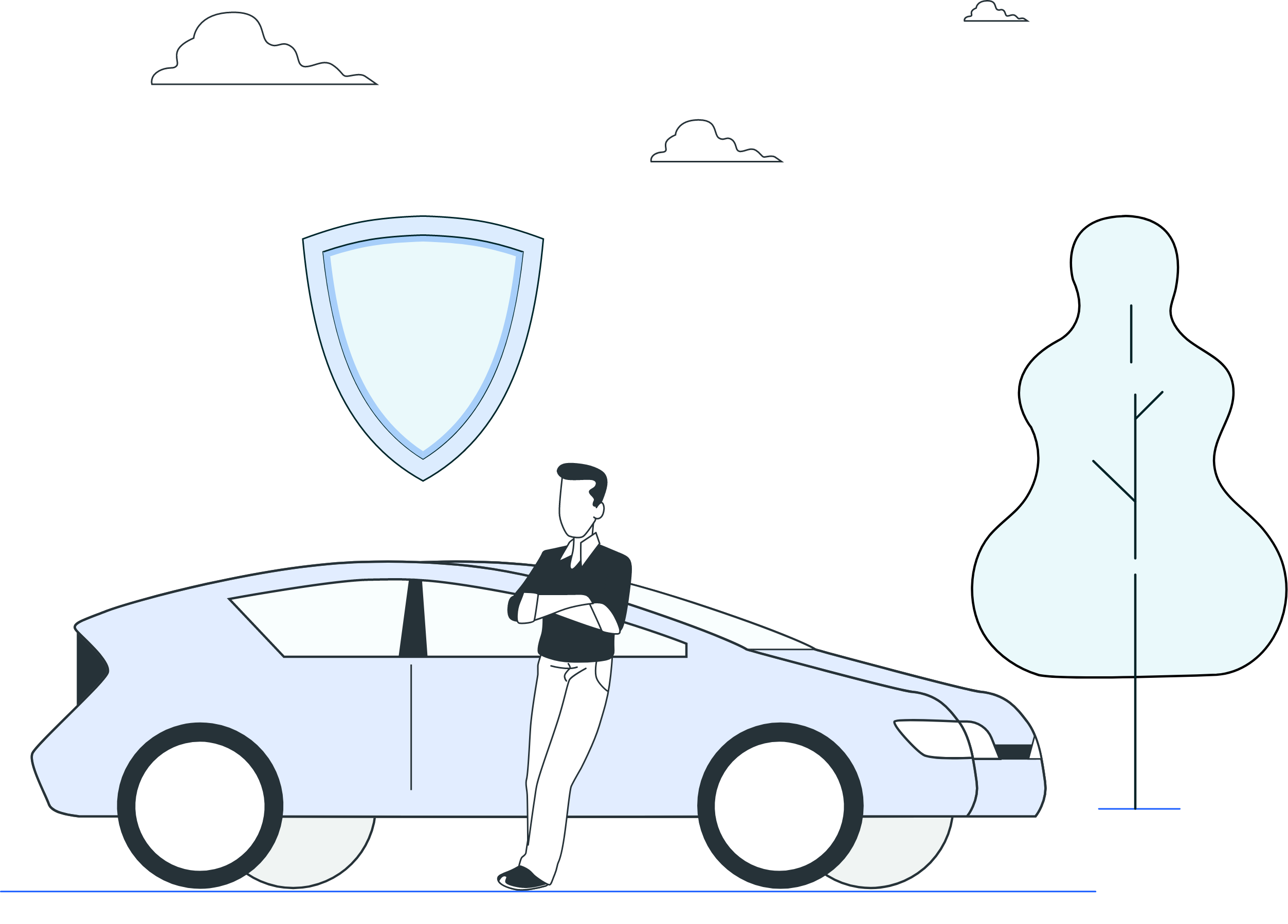What Is a Car Insurance Premium? How Does it Work?
Car insurance is a necessary cover for vehicle owners, providing protection against accidents, theft, and damage. When you buy a policy, you are required to pay a specific amount known as the car insurance premium. This payment keeps your car insured and ensures you’re covered for potential risks. The premium in car insurance can vary depending on several factors, such as the type of coverage, your car's make and model, your driving history, and where you live. Understanding how your car insurance premium is calculated can help you choose the right policy and manage costs effectively. In this article, we’ll explain what a car insurance premium is, how it works, and why it’s important to get the best deal.
Share this article
Secure Your Car With The Super Car Insurance Plan!
Believe it or Not! Save upto* 75% on TATA AIG Car Insurance

List of Content
- What Is a Car Insurance Premium?
- How Does Insurance Premium Work?
- Factors that Affect Car Insurance Premium
- What is Covered Under the Car Insurance Premium?
- How to Reduce Your Car Insurance Premium?
- Finding the Right Car Insurance Coverage
- Conclusion
- Frequently Asked Questions
What Is a Car Insurance Premium?
Your payment of a car insurance premium keeps your insurance policy active and provides coverage for your vehicle. You can purchase car insurance through online platforms or insurance agents at a specified cost.
The premium is your financial commitment to maintaining coverage that protects your car from damage, accidents, and theft. The cost of the car insurance premium depends on the level of coverage you choose, the type of vehicle you have, and factors like your location and driving history.
The premium can be paid in regular installments as per the terms of your policy, whether monthly, quarterly, half-yearly, or annually, making it easier to manage your payments.
How Does Insurance Premium Work?
A car insurance premium is the amount you pay to keep your insurance policy active and ensure that your vehicle is covered for potential risks. This premium can vary based on several factors, including the type of coverage, the make and model of your car, and your personal driving history. To understand how the premium works, let’s consider an example.
Imagine two friends, Rahul and Aman, both looking to buy car insurance. Rahul has a clean driving record and parks his car in a secure garage, making him a low-risk driver. In contrast, Aman has been involved in three accidents in the past two years and parks his car on a busy street, increasing his risk of theft. As a result, Aman’s car insurance premium is Rs. 15,000 per year, while Rahul’s premium is only Rs. 8,000.
Your premium in car insurance helps cover several important expenses:
Liability coverage: If you damage someone else’s car.
Damage repairs: Fixing your own car after an accident.
Medical expenses: If you get injured (if covered by your policy).
Legal costs: In case of a dispute.
It’s important to keep up with your premium payments, as missing them can cancel your policy, leaving you unprotected.
Factors that Affect Car Insurance Premium
Understanding how car insurance premium is calculated can help you better manage and potentially reduce your costs. Here are some of the most influential insurance premium factors:
Driving Record: A clean history usually means lower premiums.
Age & Gender: Young, single males often pay more due to higher risk profiles.
Vehicle Type: High-end or sports cars may increase your premium.
Location: Areas with high theft or accident rates can affect rates.
Coverage Type: Choosing full coverage or add-ons raises the premium.
Deductibles: Lower deductibles lead to higher premiums and vice versa.
Claims History: Frequent claims can push your premium up.
Credit Score: In many states, poor credit may increase premium rates.
Discount Eligibility: Bundled policies or no-claim bonuses can lower your premium.
What is Covered Under the Car Insurance Premium?
Your car insurance premium covers several risks, depending on your policy type—3rd party car insurance or comprehensive. Here’s what it typically includes:
Comprehensive Insurance: Protects against accidents, theft, natural disasters, and vandalism.
Standalone Own-Damage Policy: Covers only your vehicle’s damages.
Third-Party Liability: Covers damage or injury caused to others.
Additional Benefits:
Personal accident cover up to Rs. 15 lakhs.
Zero depreciation add-on for full claim settlement.
Knowing the car insurance premium meaning helps you understand what you're paying for and ensures you choose the right coverage.
How to Reduce Your Car Insurance Premium?
Want to keep your premium in car insurance under control without compromising on coverage? Here are some practical steps:
Opt for Higher Deductibles: Take on more out-of-pocket risk to lower premiums.
Bundle Policies: Combine car and home insurance for a discount.
Install Security Devices: Anti-theft tools lower risk and can reduce premiums.
Maintain a Good Driving Record: Fewer violations mean lower premiums.
Avoid Small Claims: Save claims for major issues to avoid hikes.
Choose Add-ons Wisely: Only opt for necessary extras.
Review Annually: Your premium can change based on age, location, or mileage.
Buy Car Insurance Online: Digital platforms often offer exclusive discounts.
Finding the Right Car Insurance Coverage
Choosing the right policy ensures you get the best value for your car insurance premium. Here’s how:
Assess Your Needs: Pick coverage based on how often and where you drive. Avoid overpaying for unnecessary add-ons.
Compare Plans: Get quotes from multiple insurers to find the best deal on your premium in car insurance.
Read Policy Details: Understand inclusions and exclusions to avoid surprises during claims.
Check for Add-ons: Select only essential extras to keep costs low.
Claim Settlement Ratio: A high claim settlement ratio means better chances of getting claims approved. Tata AIG offers a High claims settlement ratio, ensuring a smooth and reliable claim process.
Go Digital: Buying car insurance online can get you online savings and an easier process.
Conclusion
Your car insurance premium represents your purchase of driving security through protection services. You can reach wise choices balancing budget and requirements after comprehending car insurance premium meanings and their impact factors and calculation methods.
When renewing your policy or changing providers, becoming knowledgeable and active leads to better results. It is best to choose the insurance provider Tata AIG because its features include customisable policy options supported by tools for coverage optimisation.
So, take the wheel. Check your current insurance coverage standing to create a safer future through your driving.
Read More: No Claim Bonus in Car Insurance
Frequently Asked Questions
What happens if the insurance premium is not paid?
Unpaid car insurance premiums can lead to a policy lapsed status, which completely ends your coverage protection. You will lose financial protection when accidents or theft occur without premium payment. A lapsed policy will create obstacles when you want to renew insurance or find affordable coverage in the following period.
Can I get a refund of the insurance premium?
A policy cancellation before expiration dates makes you eligible to receive partial reimbursement of your car insurance premium. Refund amounts stem from two factors, including remaining policy duration and insurer-established refund policies. Insurance companies require policyholders to cover processing expenses that will be subtracted from the total refund amount.
Why Did My Car Insurance Premium Increase?
Your car insurance premium increase results from several factors like higher repair costs or more claims in your area or modification of your driving record or inflation patterns. Insurance premium increases can affect you whether or not you file claims due to broader market analysis and reevaluations performed by your insurer.
How long do you have to pay insurance premiums?
People generally have three options to pay their car insurance premiums: through monthly, half-yearly, or annual installments, based on their specific policy framework. Your car insurance policy may expire if you fail to pay on time, so you must fulfill payments by the due date. Insurers who accept yearly payments at once may reduce costs, but their monthly payment program helps customers handle their budget more efficiently.
What are some possible disadvantages of paying low premiums on car insurance?
People tend to pick lower premiums but receive increased costs or restricted protection along with higher deductibles when buying auto insurance. Major accidents, together with theft incidents, might force you to cover extra expenses from your pocket, which could threaten your monetary stability during unforeseen emergencies.
Secure Your Car With The Super Car Insurance Plan!
Believe it or Not! Save upto* 75% on TATA AIG Car Insurance
Share this article
Latest from our blogs

Zero Depreciation Car Insurance Cover
zero depreciation / depreciation reimbursement cover reimbur...
Read More
What is Insured declared value (IDV)?
The term ‘IDV’ refers to the maximum claim your insurer will...
Read More
How is your car insurance premium calculated?
Well it’s about time that changed, don’t you think? Read on ...
Read More